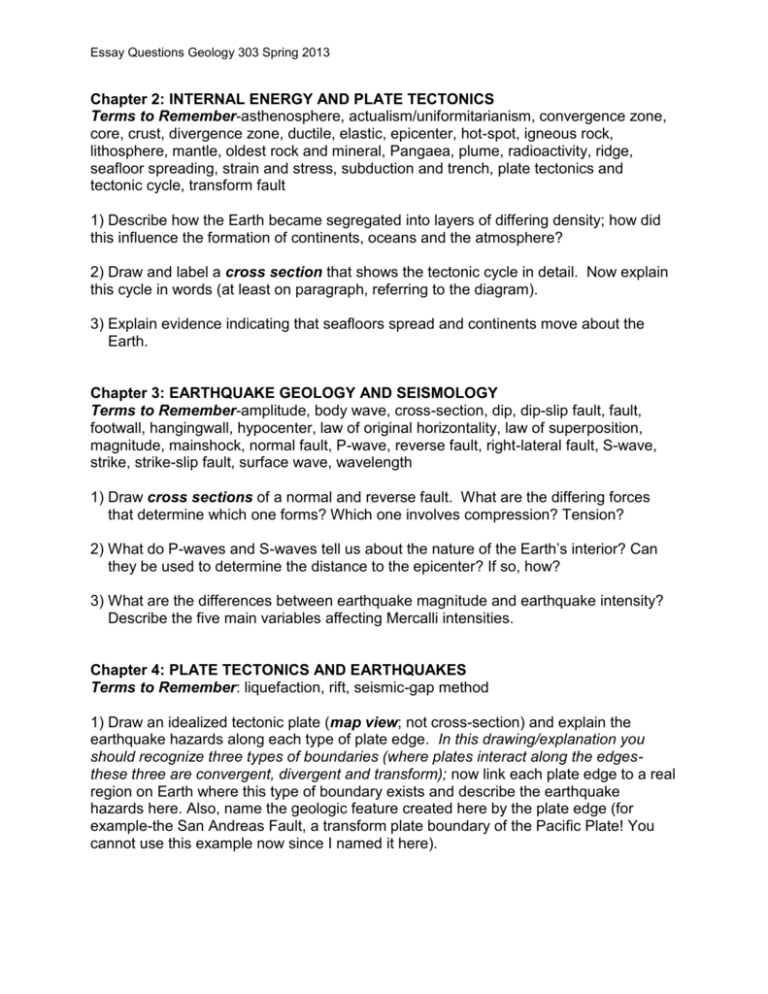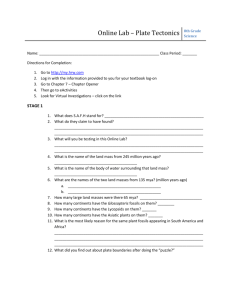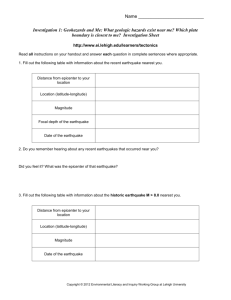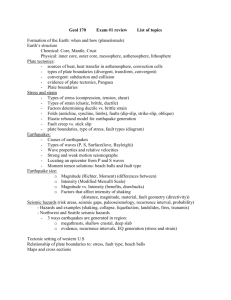Essay
advertisement

Essay Questions Geology 303 Spring 2013 Chapter 2: INTERNAL ENERGY AND PLATE TECTONICS Terms to Remember-asthenosphere, actualism/uniformitarianism, convergence zone, core, crust, divergence zone, ductile, elastic, epicenter, hot-spot, igneous rock, lithosphere, mantle, oldest rock and mineral, Pangaea, plume, radioactivity, ridge, seafloor spreading, strain and stress, subduction and trench, plate tectonics and tectonic cycle, transform fault 1) Describe how the Earth became segregated into layers of differing density; how did this influence the formation of continents, oceans and the atmosphere? 2) Draw and label a cross section that shows the tectonic cycle in detail. Now explain this cycle in words (at least on paragraph, referring to the diagram). 3) Explain evidence indicating that seafloors spread and continents move about the Earth. Chapter 3: EARTHQUAKE GEOLOGY AND SEISMOLOGY Terms to Remember-amplitude, body wave, cross-section, dip, dip-slip fault, fault, footwall, hangingwall, hypocenter, law of original horizontality, law of superposition, magnitude, mainshock, normal fault, P-wave, reverse fault, right-lateral fault, S-wave, strike, strike-slip fault, surface wave, wavelength 1) Draw cross sections of a normal and reverse fault. What are the differing forces that determine which one forms? Which one involves compression? Tension? 2) What do P-waves and S-waves tell us about the nature of the Earth’s interior? Can they be used to determine the distance to the epicenter? If so, how? 3) What are the differences between earthquake magnitude and earthquake intensity? Describe the five main variables affecting Mercalli intensities. Chapter 4: PLATE TECTONICS AND EARTHQUAKES Terms to Remember: liquefaction, rift, seismic-gap method 1) Draw an idealized tectonic plate (map view; not cross-section) and explain the earthquake hazards along each type of plate edge. In this drawing/explanation you should recognize three types of boundaries (where plates interact along the edgesthese three are convergent, divergent and transform); now link each plate edge to a real region on Earth where this type of boundary exists and describe the earthquake hazards here. Also, name the geologic feature created here by the plate edge (for example-the San Andreas Fault, a transform plate boundary of the Pacific Plate! You cannot use this example now since I named it here). Essay Questions Geology 303 Spring 2013 2) Explain why earthquakes at subduction zones are many times more powerful than spreading-center earthquakes. Now compare/contrast the earthquake potential at the Peru-Chile Trench Zone to the earthquake hazards along the Mid-Atlantic Ridge. 3) Compare and contrast two major earthquakes of the past (that are discussed in your book). You cannot pick earthquakes to compare/contrast that were generated along the same type of plate boundary (i.e., your choices are comparing convergent to divergent; convergent to transform (strike-slip) or divergent to transform (strike-slip) generated earthquakes). Discuss how these earthquake’s were generated, the hazards associated with each and the effects on people. Chapter 8: TSUNAMI VERSUS WIND-CAUSED WAVES Terms to Remember: fetch, rogue wave, seiche 1) What is the energy source of: (a) everyday waves at the beach?; (b) tidal waves?; (c) tsunami? Why is tsunami more powerful than everyday waves? (when explaining this, discuss four causes of tsunami; also sketch and discuss wavelength, period and velocity of tsunami versus everyday waves). 2) Draw a cross section and explain why an ocean wave breaks as it nears the shoreline. Discuss wavelength and wavebase in your explanation. 3) Which two types of fault movements of the seafloor can generate the most powerful tsunami: reverse (thrust), normal or strike-slip? Why/how (explain in detail with words and a sketch). TEST 1: Four Essay Questions worth 5 points each and 30 multiple choice/true false questions. Essay Questions Geology 303 Spring 2013 Chapter 6: VOLCANIC ERUPTIONS: PLATE TECTONICS AND MAGMAS Terms to Remember: ash, aa, basalt, caldera, cinder cone (scoria cone), composite volcano (stratovolcano), crater, crystallization, decompression melting, fissure, flood basalt, lahar, lava dome, mineral, obsidian, pahoehoe, plutonic rock, pumice, pyroclastic and pyroclastic flow, rock, shield volcano, viscosity, volcanic rock 1) Why do volcanoes above subduction zones erupt more explosively than volcanoes at spreading centers? Explain further now, why do volcanoes in the ocean tend to erupt peacefully, whereas volcanoes on continents tend to erupt explosively? What explains these differences? 2) Play the three V’s game. Pick various low, medium and high values for viscosity, volatiles and volume, and then describe the resultant eruption styles and volcanic landforms. Do this for at least 4 landforms. 3) Compare and contrast the eruption of the volcano Krakatoa in 1883 to the creation of the Santorini caldera during the eruption of the volcano Santorini during 1628 BCE. Make sure to discuss the plate tectonic settings of each and the effects on people, along with hazards generated during each eruption. Chapter 7: VOLCANO CASE HISTORIES: KILLER EVENTS Terms to remember: 1) Discuss four ways of creating pyroclastic flows. Why do they travel so fast? How do they kill? Can they travel over water and still be hot enough to kill people? Discuss an example of a case history where pyroclastic flows caused a natural disaster. 2) What three factors combine to produce lahars? (See lahars at Kelut). Draw a cross section and explain how lahars form and move. How do they kill? Now explain the hazard Mount Rainier presents to the Seattle-Tacoma region. 3) Compare and contrast the eruption of Mount St. Helens in 1980 to the 79 CE eruption of Mount Vesuvius. Make sure to discuss the plate tectonic setting that creates each volcano and the effects on people, along with hazards generated during each eruption. Chapter 16: IMPACTS WITH SPACE OBJECTS Terms to Remember: asteroid, comet, Kuiper Belt, maria, meteor, meteroid, NEO, Oort Cloud, shooting star, solar wind, tektite 1) List and explain the evidence you could collect to demonstrate that a specific area was the site of an ancient asteroid impact. Discuss this evidence in detail! 2) Describe the sequence of life-threatening events that occur when a 10 km (6 mile) diameter asteroid slams into Earth. Describe in detail! Essay Questions Geology 303 Spring 2013 3) Compare and contrast the origin of Meteor Crater in Arizona to the Chicxulub crater in the Yucatan, Mexico. What consequences did each have on species living during that time period? Chapter 14: FIRE Terms to remember: backfire, combustion, conduction, diffusion, fire, firestorm, foehn winds, fuel-driven fire, heat, oxidation, pyrolysis, radiation, wind-driven fire 1) Sketch and explain the fire triangle and its components in detail. 2) Explain the stages of fire and the four factors influencing the spread of fire in detail. 3) If you were designing your dream house on your dream lot, what features could you incorporate into the house and landscape design to better protect your house from destruction by fire? TEST 2: Four Essay Questions worth 5 points each and 30 multiple choice/true false questions. Chapter 9: EXTERNAL ENERGY FUELS WEATHER AND CLIMATE Terms to Remember: climate, Coriolis effect, cyclone, adiabatic process, albedo, Essay Questions Geology 303 Spring 2013 anticyclone, dew-point temperature, front, greenhouse effect, heat capacity, humidity, isobar, lapse rate, latent heat, lifting condensation level, monsoon, pressure gradient, solar radiation, stratosphere, thermohaline flow, troposphere 1) Explain the greenhouse effect in detail and name some of the important greenhouse gases. Which greenhouse gas are we most concerned about today? Why? (see Chapter 12 beginning on page 328 for more detail on this). 2) Explain the adiabatic cooling that occurs in a rising air mass (sketch a cross sectional view of the lower atmosphere for this explanation). In your hypothetical explanation, this rising air mass will reach saturation (or lifting condensation level and the dew point temperature) at 2 km and will remain warmer than the air around it, so explain its rise past 2km. Is the lapse rate in a rising mass of air greater in dry or moist air? (Make sure to explain how relative humidity changes in rising/expanding air and the effects of latent heat when water vapor changes state to liquid water which we see as clouds). 3) (a) Use the terms high pressure, low pressure and pressure gradient to explain how winds form; (b) What are the relationships between high and low pressure zones and between cyclones and anticyclones? 4) What causes the surface circulation of water throughout the oceans (surface currents)? Explain. What causes the global circulation of water deep within the ocean (thermohaline circulation)? Explain. Now explain the general effects on climate if these surface and deep circulation patterns stopped circulating. Chapter 10: TORNADOES, LIGHTNING, HEAT AND COLD Terms to remember: air-mass thunderstorm, cumulus, derecho, downburst, freezing rain, hypo and hyperthermia, lake-effect snow, lightning, mesocyclone, nor’easter, severe thunderstorm, supercell thunderstorm, thunder, thunderstorm, tornadoes and tornado outbreak 1) Sketch a series of vertical cross sections showing the stages of development of a late-afternoon thundercloud. Label the processes occurring in the cloud during each stage. Now sketch a series of cross sections (at the vortex scale) showing the stages of tornado formation. Why are tornadoes potentially more destruction than thunderstorms? Discuss hazards associated with each. 2) Draw a map (map view) and explain how a Gulf of Mexico warm air mass, a Canadian cold air mass and the polar-front jet stream can meet and generate Essay Questions Geology 303 Spring 2013 tornadoes. Now, what land and air conditions make the central United States the tornado capital of the world? Chapter 11: HURRICANES Terms to remember: eye and eyewall, hurricane, surge 1) Compare a tornado to a hurricane. Discuss how each typically forms in detail with cross-sectional sketches. Which has the most total energy? Which has the highest wind speeds? Label the internal flow of winds and for the hurricane, explain the eye. 2) (a)Discuss the hazards associated with a hurricane (typhoon/cyclone) and cite examples of at least two case histories where these hazards caused much destruction and death; (b)then discuss mitigation measures that can be taken to reduce damages and death from hurricanes (please note: having a first aid kit isn’t a mitigation measure). Chapter 12: CLIMATE CHANGE Terms to remember: El Nino, extinction, La Nina, Little Ice Age, methane, Milankovitch theory, ozone, sunspot, tipping point 1) Climate is related to the amount of solar radiation received on Earth. How is incoming solar radiation affected by (a) continental ice sheets?; (b) volcanic ash in the stratosphere?; (c) elevated levels of atmospheric CO2?; and (d) SO2 blown into the stratosphere by volcanic eruptions? Explain each in detail. 2) What causes glacial advances and retreats during an ice age (see timescale in thousands of years)? (make sure to discuss Milankovitch theory). 3) When massive continental ice sheets melt, what happens to (a) sea level?; (b) deepocean-water circulation?; (c) salinity of sea-surface waters?; (d) organisms living near the sea surface? Discuss in detail. 4) Describe what happens to produce the El Nino phenomenon? What changes does it bring to Australia? To California? Now discuss what happens during La Nina. TEST 3: Four Essay Questions worth 5 points each and 30 multiple choice/true false questions.









